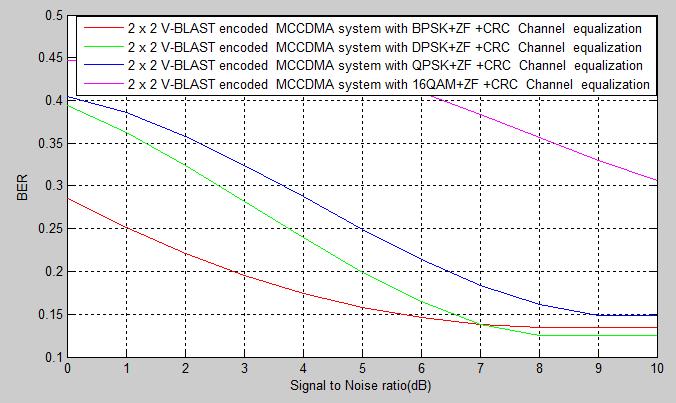
2 minute read
International Journal of Ambient Systems and Applications (IJASA) Vol.8, No.1/2, June 2020
The BER performance of 2×2 V-BLAST MIMO MCCDMA system for 31st image frame with BPSK, DPSK, QPSK and 16QAM digital modulation scheme under Convolution and CRC channel coding with ZF signal detection scheme is shown in Fig. 3. It shows that the BPSKmodulated system achieves a performance gain of 12.09 dB at an SNR value of 3 dB; the BER values for BPSK and 16QAM are found to be 0.1850 and 0.4712, respectively. The lowest order BPSK modulated system shows best performance in video signal transmission as compared to other modulations under consideration.

Advertisement
International Journal of Ambient Systems and Applications (IJASA) Vol.8, No.1/2, June 2020 outperforms in BPSK and shows worst performance in 16QAM modulation The BER values decreases with increasing SNR and vice-versa. For BPSK and 16QAM modulation, the BER values are 0.1931 and 0.4641, respectively for a 3 dB SNR value which indicates that the system achieves a performance gain of 11.99 dB with BPSK modulation.
A similar performance result (as for the 1st and 31st frames) is obtained for the 71st image frame as shown in Fig. 4 It shows that the BER values for a SNR value of 3 dB are 0.1979 and 0.4508 for BPSK and 16QAM digital modulations, respectively which implies that the system achieves a performance gain of 11.80 dB with BPSK modulation in video data transmission.


The BER dependence of for the 2×2 V-BLAST MIMO MCCDMA system for the 141st image frame is shown in Fig. 6. It is observed that for the SNR value of 3 dB, the system’s performance attains gain of 11.89 dB, 10.25 dB, 9.55 dB and 8.11 dB with BPSK, DPSK, QPSK and 16QAM modulation schemes, respectively which indicate that the BPSK modulated VBLAST MIMO MCCDMA system shows best performance in video data transmission.
From the above comparative analysis of the BER performance results under BPSK, DPSK, QPSK and 16QAM modulation, it is clear that the implementation of BPSK digital modulation scheme with the deployment of convolution and CRC channel encoding and the ZF signal detection scheme in V-BLAST MIMO MCCDMA wireless communication system provides satisfactory results in video data transmission.
The BER values of the V-BLAST MIMO MCCDMA system at a fixed SNR of 3dB for different modulation schemes at the selected image frames of the video signal are summarized in Table 2. It is evident that the BER values for the BPSK modulated system is lowest while that of the 16QAM modulation is highest for each of the image frames. These simulation results show that the BPSK modulated V-BLAST MIMO MCCDMA system with the employment of convolution and CRC channel encoding and ZR signal detection technique outperforms in video data transmission while the 16QAM modulated system shows worst performance.
Table 2. BER values at SNR of 3dB for BPSK, DPSK, QPSK and 16 QAM modulations at selected framenumbers of the transmitted video signal.
5. CONCLUSIONS
In this paper, the performance of V-BLAST encoded 2×2 MIMO MC-CDMA wireless communication system has been investigated based on their bit error rates and signal-to-noise ratio on video transmission with the employment of ½-rated convolution and CRC channel coding and ZF signal detection scheme under BPSK, DPSK, QPSK and 16-QAM digital

